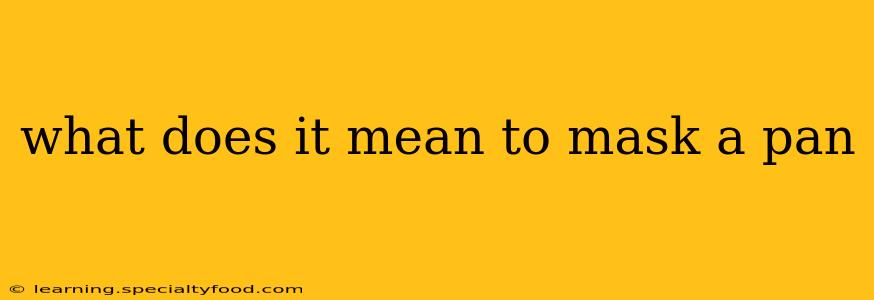What Does It Mean to Mask a Pan?
"Masking a pan" refers to a crucial step in the process of preparing a pan for cooking, particularly when dealing with non-stick cookware or delicate surfaces. It's not about hiding the pan; rather, it's about creating a protective barrier between the cooking surface and the food. This prevents sticking, burning, and ensures even cooking. Let's delve into the specifics.
Why Mask a Pan?
Masking a pan is primarily done to prevent food from sticking. This is especially important with:
- Non-stick pans: While designed to prevent sticking, even non-stick surfaces can benefit from masking, especially when cooking at high temperatures or with acidic foods. Masking helps maintain the integrity of the non-stick coating and extend its lifespan.
- Delicate pans: Some pans have delicate finishes or coatings that are easily damaged. Masking provides a protective layer to prevent scratching or discoloration.
- Even cooking: A properly masked pan allows for more even heat distribution, preventing hot spots and ensuring that your food cooks evenly.
How to Mask a Pan: Different Techniques
The "masking" technique varies depending on what you're cooking. Here are some common methods:
-
Oil: This is the most common masking technique. A thin layer of oil, such as vegetable oil, canola oil, or even butter, is spread across the cooking surface before adding the food. The oil creates a barrier that prevents direct contact between the food and the pan. The type of oil often depends on the cooking temperature and desired flavor profile.
-
Butter: Similar to oil, butter adds flavor and helps prevent sticking. It's particularly useful for dishes that benefit from a buttery flavor, but use it cautiously at high temperatures as it can burn.
-
Spray Oil: Cooking sprays offer a convenient way to apply a light coating of oil. Be mindful not to use too much, as excess oil can lead to splattering and unwanted grease.
-
Parchment Paper or Silicone Mat: For certain cooking methods, such as baking or roasting, parchment paper or a silicone mat can act as a mask, separating the food from the pan's surface. This is especially useful when dealing with sticky foods or delicate pastries.
What Happens if You Don't Mask a Pan?
Failing to mask a pan can result in several problems:
- Sticking: Food sticks to the pan, making it difficult to remove and potentially damaging the pan's surface.
- Burning: Food can burn easily if it comes into direct contact with a hot pan, especially without sufficient oil or butter.
- Uneven Cooking: Hot spots on the pan can lead to unevenly cooked food.
- Damage to the Pan: Without masking, food can scratch or damage the non-stick coating or delicate surface of certain pans.
What is the best way to mask a pan?
The "best" way to mask a pan depends on the specific recipe and type of cookware. Generally, a thin, even layer of oil or butter is sufficient for most dishes. For delicate pans or high-heat cooking, a very light layer is recommended to prevent burning or smoking. Experiment to find what works best for you and your cookware.
In summary, masking a pan is a simple yet essential technique that helps prevent sticking, ensures even cooking, and protects your cookware. It's a fundamental skill for any cook, regardless of experience level.
